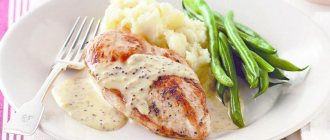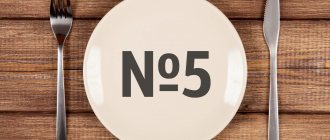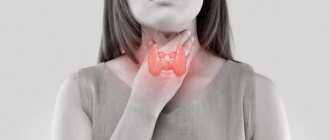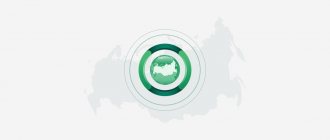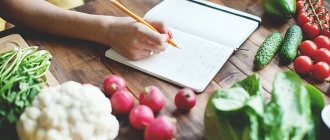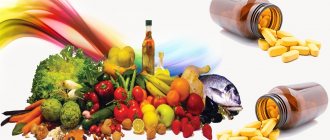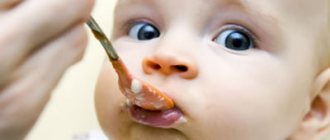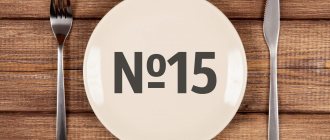The founder of gastroenterology and diet therapy in the USSR is considered to be the therapist, one of the organizers of the Institute of Nutrition in Moscow, Manuil Pevzner. The dietary nutrition system that he developed is aimed at treating certain diseases and is called the “table”. Nutrition programs according to Pevzner have been successfully used by doctors since the middle of the last century.
Let us consider in detail the second diet from this list, which is used for chronic diseases of the stomach and intestines, in particular, chronic gastritis with secretory insufficiency. Table No. 2 can be used for enteritis and colitis not only during the period of restoration of intestinal function, but also during the period of exacerbation. Another such diet is often prescribed after operations in the rehabilitation phase, as well as during the recovery phase after infectious diseases. We will learn what you need to eat and in what form, what you can prepare, and how to create a menu.
The essence and purpose of the diet
Treatment table No. 2, as a rule, is used in the period after an exacerbation of the inflammatory process of the stomach and intestines; before that, diet No. 1 is used. It is important to know that such a diet may not be suitable for patients with concomitant diseases of the pancreas, liver and gallbladder.
Therefore, such a diet should be prescribed exclusively by a gastroenterologist based on the general condition of the patient and the results of laboratory and instrumental tests. : If the patient's condition worsens and the symptoms of the disease progress, the doctor prescribes a different course of treatment and diet.
Content:
- The essence and purpose of the diet
- Eating on a diet
- Menu for table No. 2
- Dietary dishes for table No. 2
- Finally
The goal of this program is to stimulate the normal secretion of digestive enzymes. With the virtual absence or insufficient production of digestive juices, the normal process of digestion is impossible.
That is why the goal of diet therapy using table No. 2 is to restore digestive function. In addition, during therapeutic nutrition, the motility of the digestive tract improves. Gastrointestinal motility ensures the movement of food through the digestive tract and its mixing with gastric juice. Violations of this function are also dangerous and extremely undesirable.
Table number 2 is characterized as a complete and balanced diet. The list of prohibited foods includes hard-to-digest, fatty and spicy foods. Almost all types of heat treatment are allowed. The patient must eat at least 2800 kcal per day, this is the daily caloric intake for an ordinary person. That is, you don’t have to starve or severely restrict yourself, and it’s not even allowed. Particular attention is paid here to mechanical sparing.
The chemical composition of the diet should consist of all the vitamins and microelements the body needs. Every day you need to consume approximately 100 g of proteins and fats, both vegetable and animal, and supplement with 400 g of carbohydrates.
To accurately navigate the amount of components consumed, it is better to find recipes indicating the content of proteins, fats, carbohydrates, as well as calorie content per 100 g of dish or food product. Such recipes are most common on websites for athletes and health portals. In general, you need to eat a little of everything a day: dietary meats, poultry, white fish, cereals, vegetables, fruits. It is recommended to eat plant foods not raw, but cooked. You also need to limit the amount of salt - no more than 15 grams per day.
Mechanical processing of dishes for table No. 2: food should be finely chopped, pureed, soft, mushy. Lean fish fillets do not need to be chopped; the main thing is to eat them without skin. Everything else should be in the form of baby food, soups - not rich and liquid (not bone and with a second broth), porridge - pureed, fillets for cutlets and meatballs - it is better to pass through a meat grinder several times.
Heat treatment: the diet should consist of approximately 80% boiled or steamed foods. Food can also be baked, stewed or fried. The main thing is that there is no thick crust. When frying, it is not allowed to use breading in breadcrumbs or batter with flour. The food consumed should only be warm: not very cold and not too hot. It is also not allowed to overeat; there should be 4-5 moderate servings per day.
So, to recover from gastritis and related diseases, you need to eat warm, soft food, divided into 4-5 meals. You can't overeat and starve. The basis of the diet should be cooked ingredients.
Mechanism of therapeutic action
By choosing certain food products, as well as determining a rational regimen for their intake, several mechanisms of the therapeutic effect of diet 2 on the human body are realized:
- Providing the body with all the necessary vital organic compounds, vitamins and minerals.
- Reducing the load on all parts of the digestive tract, which promotes faster restoration of tissues that have undergone the development of a pathological process.
- Improving the digestion process due to moderate stimulation of the functional activity of the glands. This leads to better absorption of ingredients.
- Faster tissue regeneration in the area of development of the pathological process, which is facilitated by a balanced content of nonessential and essential amino acids in the diet.
The mechanism of the therapeutic effect of diet 2 is realized to a greater extent after a sufficiently long period of compliance with the basic recommendations, as well as the prescription of drug therapy if necessary.
Eating on a diet
Flour for baking should be 1st 2nd milling and only made from wheat. Baked goods must be dried, baked the day before use. Once every three to four days you can eat pies or dried pies; the filling must be made from acceptable ingredients.
It is forbidden:
- puff pastries and cookies;
- baked goods;
- dark bread;
- hot pastries.
Be sure to eat liquid food at least once a day. Broths for first courses can be made with mushrooms or vegetables. It is not prohibited to use vermicelli, finely chopped vegetables, and permitted cereals for the first one. If meat is used for the broth, it must be boiled twice, and the soup should be cooked in secondary broth. Use only lean meats. Light fish soup made from lean fish and borscht (with a minimum content of white cabbage) are also allowed.
The first one is not allowed with:
- with milk or kefir;
- beans;
- strong broth;
- with millet.
Lean meat without layers of fat and skin is allowed. Boiled tongue and natural sausages are allowed (milk sausages are possible). You can cook rabbit, chicken, turkey, young beef, and game. Lamb and pork are limited (possible, but as little as possible). Fish with white, lean meat is suitable: crucian carp, hake, cod, etc.
It is forbidden:
- old lamb, beef, streaky pork, goose, duck;
- other types of meat and fish, smoked or raw;
- canned food, marinades.
Cereals (except those prohibited) can be added to diet cutlets, puddings, and baked pancakes. You can use water as a base for porridge or add a third of milk to it. They must be ground before serving. Millet can be eaten up to 2 times a week.
It is forbidden:
- barley;
- barley;
- corn;
- all types of beans.
Plant food. Only fully ripe fruits are allowed. Several times a week (if well tolerated) green peas are introduced into the diet. Mousses, purees, jelly, steamed vegetables, lean roasts, smoothies are served in pureed form (after heat treatment).
Do not use:
- bell pepper;
- radishes and radishes;
- mushrooms;
- garlic;
- cucumbers;
- onion.
Among fruits and berries, fruits with rough skin and seeds are prohibited: figs, dates. Raspberries, currants and gooseberries are also not used.
Eggs. You can use any: quail, chicken, turkey, goose. If you are frying fried eggs or omelettes, do not allow a crust to form. You can cook it soft-boiled, steamed or poached.
Don't: Hard-boiled eggs.
Milk products. Low-fat milk, kefir, yogurt, natural yoghurts without additives. You can use a little grated hard cheese. Cottage cheese can be used for dishes or eaten in its natural form. You can add cream and a little sour cream to drinks and food (15 g per dish).
It is forbidden:
- fatty milk products;
- cheeses with nuts, high salt content or spicy ones.
Drinks – light coffee and cocoa. You can use weak decoctions and teas, sometimes with lemon. Natural juices from fruits, berries and vegetables should be diluted with clean water. It is recommended to periodically consume a decoction of bran (it has an enveloping effect on the inflamed mucous membrane of the stomach and intestines, and mild stimulation of motility). Also, a herbal decoction of rose hips has a very good effect on digestion, which in addition has a vascular strengthening effect.
Do not use:
- carbonated drinks;
- alcoholic drinks;
- grape juice.
Dessert. Baked fruits, boiled berry purees, dried fruits, and pureed dried fruits are not prohibited. Buckwheat or May honey is added to dishes, teas and infusions. Natural nougat, jam, marshmallows, liquid preserves, meringues and marmalade are allowed. You can also drink sweet decoctions based on fruits and berries, jelly.
It is forbidden:
- fresh baked goods;
- chocolate and cream products;
- cold desserts;
- yoghurts with additives.
Hot, sour and fatty spices and sauces are also prohibited: mustard, adjika, ketchup, mayonnaise, horseradish. Animal and cooking fats should not be used for cooking: margarine, spread, lard, etc. You can add finely chopped greens to dishes.
Let's look at a sample menu for a week to make it easier to navigate the treatment program.
Contraindications
There are several of the following medical contraindications for prescribing diet 2:
- Pathological processes in the stomach, accompanied by an increase in the functional activity of the glands and an increase in secretion (hyperacid gastritis).
- Peptic ulcer of the stomach or duodenum.
- Erosive esophagitis (inflammation of the mucous membrane of the esophagus), which is the result of backflow of gastric contents caused by various reasons.
- Individual intolerance to most of the permitted foods that form the basis of the diet for diet 2.
- Food allergies caused by foods taken while following dietary recommendations.
If there is an individual intolerance or food allergy, the doctor makes adjustments to dietary recommendations, and the list of permitted products is usually significantly reduced.
Menu for table No. 2
Since the list of allowed products contains almost all the necessary ingredients, creating a menu will not be difficult. Also, there are practically no restrictions for heat treatment: any available methods, except for heavily fried. You can make individual adjustments and dishes to the menu, focusing on the rules of the therapeutic course.
Monday
Breakfast: boiled eggs, fruit jelly, coffee with milk.
Lunch: soup with beef, potatoes, noodles and herbs.
Afternoon snack: natural yogurt, honey apple in the oven.
Dinner: buckwheat with stewed chicken meatballs.
Before bed: natural yogurt.
Tuesday
Breakfast: cheese omelette made from proteins, coffee with cream and sugar.
Lunch: tomato soup, a portion of mashed potatoes.
Afternoon snack: tea with crackers.
Dinner: soft rice and fish quenelles.
Before bed: kefir.
Wednesday
Breakfast: light semolina with the addition of finely chopped dried apricots, coffee.
Lunch: soup with boiled cereals and vegetables, dried bread.
Afternoon snack: strawberry broth, homemade jelly.
Dinner: lean vegetable roast, separately a piece of boiled veal.
Before bed: yogurt.
Thursday
Breakfast: fried eggs, boiled milk sausage, coffee with milk.
Lunch: lean fish broth, dried bread.
Afternoon snack: semolina pudding, tea.
Dinner: diet steamed chicken cutlets with a side dish of vermicelli.
Before bed: kefir.
Friday
Breakfast: cocoa, oatmeal with milk.
Lunch: beetroot without meat, bread.
Afternoon snack: tea with marmalade.
Dinner: quenelles in sour cream sauce, some soft rice.
Before bed: natural yogurt.
Saturday
Breakfast: boiled sausage, eggs, coffee with cream.
Lunch: cream soup with chicken and broccoli or cauliflower.
Afternoon snack: honey and dried cookies, tea.
Dinner: baked cod without skin, carrot puree.
Before bed: yogurt.
Sunday
Breakfast: sandwiches made from wheat bread with hard cheese, coffee with milk.
Lunch: rassolnik (brine instead of cucumbers).
Afternoon snack: baked pear with powdered sugar, tea.
Dinner: noodle soup with minced meat, juice and water.
Before bed: kefir.
It is important to drink a normal amount of purified water throughout the day, most importantly not during meals. Water dilutes gastric juice and food is not digested normally. After eating, you need to wait 15-20 minutes and only then drink water. It is recommended to drink a glass of fermented milk drinks at night. You can use salt for cooking, but in minimal quantities. Strict adherence to all diet rules ensures a speedy recovery and transition to a nutritious diet.
Indications
There are several medical indications on the basis of which a specialist gastroenterologist, internist, pediatrician or family doctor prescribe diet 2, these include:
- Acute gastritis (inflammation of the stomach), enteritis (inflammation of the small intestine) or colitis (inflammation of the colon) at the stage of gradual restoration of the functional state of the digestive system, as well as a decrease in the severity of pathological changes. Diet 2 is prescribed for the purpose of a smooth transition to normal nutrition.
- Chronic enteritis or colitis, which has an isolated long-term course of more than six months and is not accompanied by inflammation of the liver tissue (hepatitis), structures of the hepatobiliary system (cholecystitis, cholangitis), as well as the stomach with a concomitant increase in secretion and acidity.
- Chronic gastritis, in which the functional and secretory activity of the stomach is characterized by a slight decrease. The diet is usually prescribed at the stage of exacerbation of the pathological process.
The use of dietary recommendations is justified to prevent the development and manifestation of pathological conditions, as well as to prevent exacerbation (relapse) of chronic pathology.
Dietary dishes for table No. 2
A wide list of products allows you to show your imagination in creating a diet. Despite the fact that the food system is medicinal, there can be many options for dishes: puddings, casseroles, stews, soups, desserts and much more. As an example, let's look at some recipes for table No. 2.
Oatmeal pudding is suitable for breakfasts, afternoon snacks and as a main course.
To prepare, boil 2 cups of oatmeal with milk and sugar and leave to cool. At this time, grate the pumpkin (one cup). Place the pumpkin in a frying pan, add one glass of milk and simmer until tender. Mix both masses. Beat 2 egg whites until foamy and add to the pumpkin mixture, stirring constantly. Place the resulting dough in a greased pan, spread sour cream on top and bake until done. You can check the degree of readiness using a toothpick.
Fish pate is suitable for breakfast sandwiches or snacks.
One boiled carrot and 100 g of cottage cheese need to be ground until smooth. Separately, boil 200 g of cod fillet (you can use hake), pass it through a meat grinder and simmer the minced meat until the moisture evaporates. Combine both masses and beat well.
Kissel with dried apricots is great as a dessert or drink. You can take it in a thermos to work or for a walk.
Dried apricots (any amount) need to be boiled in water for 30 minutes. Then wipe the dried fruits and return them to the broth. Separately, mix starch with clean water (1:4), at the rate of 15 g of starch per 200 ml of broth. Introduce starch solution into a boiling broth with pureed dried apricots in a thin stream and immediately turn off. If the jelly is placed in portioned dishes (cremankas, glasses), sprinkle it with powdered sugar on top to prevent a crust from forming.
Best materials of the month
- Coronaviruses: SARS-CoV-2 (COVID-19)
- Antibiotics for the prevention and treatment of COVID-19: how effective are they?
- The most common "office" diseases
- Does vodka kill coronavirus?
- How to stay alive on our roads?
Prohibited Products
The use of dietary recommendations of table 2 implies the exclusion of the following foods:
- Raw vegetables without prior chopping.
- Legumes, as well as any dishes made from them, including soup.
- Okroshka.
- Pearl barley, barley, corn grits.
- Pickles, marinades, mushrooms.
- Pepper, garlic, radish, rutabaga, radish.
- Ice cream, chocolate in any form, confectionery with cream.
- Hard fruits or berries containing seeds (raspberries, hard-skinned gooseberries, dates, figs).
- Lard, beef, lamb fat.
- Kvass, grape juice.
- Fatty hot sauces, mustard, spices.
- Flour products made from rich, puff pastry.
Doctor's opinion
Diet 1 was developed by physician Pevzner for the complex treatment of chronic pathology of the stomach, small and large intestines. It contains all the organic compounds, vitamins and minerals necessary for the human body. With the use of dietary recommendations, it is possible to significantly reduce the load on the gastrointestinal tract, as well as to slightly increase the activity of the digestive glands. After the first few weeks of using Diet 2, the severity of manifestations of the pathological process from the hollow structures of the gastrointestinal tract noticeably decreases, and the general condition of the person improves. The table can be assigned to a medical hospital or to outpatients. It can be used to prevent the development of pathological processes in the digestive system.

